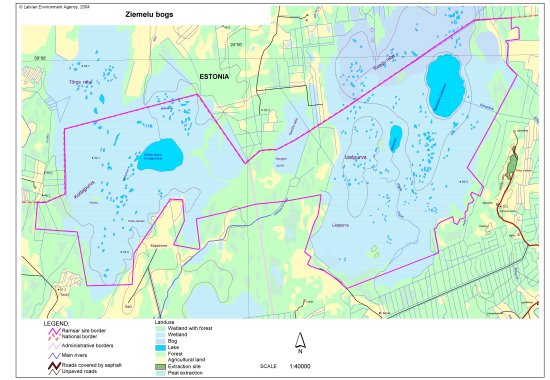Latvia names three new boggy sites for the Ramsar List

Three valuable new Wetlands of International Importance in the Baltic region
The Secretariat is very pleased to announce that Latvia has designated three new wetlands for the List of Wetlands of International Importance, effective 31 October 2002, bringing that Party's total number of Ramsar Sites to six. Two of the new sites are at the national frontiers and at least one of them has the potential to become part of a Transboundary Ramsar Site, i.e., a single transboundary wetland system managed collaboratively by the Parties concerned, in this case between Latvia's Northern Bogs and Estonia's Nigula Nature Reserve. All three valuable sites exhibit a range of Ramsar Criteria for  international importance but all are united in meeting the waterbird Criteria, particularly Criterion 6 by regularly supporting 1% of the individuals in a population of one species or subspecies of waterbird. Ramsar's Assistant Advisor for Europe Estelle Gironnet has prepared these brief summaries of the new sites.
international importance but all are united in meeting the waterbird Criteria, particularly Criterion 6 by regularly supporting 1% of the individuals in a population of one species or subspecies of waterbird. Ramsar's Assistant Advisor for Europe Estelle Gironnet has prepared these brief summaries of the new sites.
The Lubana Wetland Complex (48,020 ha; 56°49'N 026°54'E) in Madona, Rezekne, Balvi, and Gulbene administrative regions is a nature reserve and the largest wetland in Latvia, with a shallow freshwater lake, 7 raised and transitional bogs and fens, inundated grasslands, fishponds and wet forests - in total, 15 protected habitats of European importance are represented. The site is important for maintaining bog-specific and rare bird species and wetland characteristic plant species and communities. More than 26,000 waterfowl birds rest in the area during spring migrations, especially large flocks of Bewick's Swan, Whooper Swan, and Pintail, and the site supports some particularly protected bird species like Haliaeetus albicilla, Aquila clanga, Gallinago media, Crex crex and protected mammals such as Castor fiber, Lutra lutra, Canis lupus, Ursus arctos, Lynx lynx. The main human activities are forestry, marginal non-intensive agriculture, and fishery. Drainage and dam constructions have damaged the wetland structure and threaten the fish population. A LIFE-Nature project approved in 2003 is intended to implement an environmental management plan to achieve sustainable development by 2010. Ramsar site no. 1384.
The site called Northern Bogs (Ziemelu purvi) (5,318 ha., 57°58'N 024°50'E) in Limbazi and Valmiera regions is both a protected nature area and part of a UNESCO Biosphere Reserve. The site comprises two large raised bogs which are divided by the border with Estonia. Together with Nigula Nature Reserve in Estonia (Ramsar site no. 910) located 1 km westwards from the Kapzemes bog, the area comprises one of the largest untouched wetland complexes in the Baltic Republics. It supports an appreciable assemblage of rare, vulnerable and endangered species of birds and plants, some of them occurring in great numbers or densities especially during migration. In autumn, at least 10,000 Anser fabalis and A. albifrons are roosting. Breeding species include Circus pygargus, Falco columbianus, Grus grus, Philomachus pugnax. The wetland complex plays an important role as a water storage in stabilising runoff. Land use is essentially berry picking and local fishing. Diminution of agricultural lands outside the wetlands has a negative impact on food availability for some birds and mammals. Various state monitoring programmes are carried out within the complex. A joint management plan for the transboundary wetland complex is currently being developed with Nigula Nature Reserve (Estonia). Ramsar site no. 1385.


The Pape Wetland Complex (51,725 ha; 56°10'N 020°55'E) in Liepaja district borders Lithuania at the south and is unique in the diversity of ecosystems concentrated in relatively small territory, including coastal lagoon, oligo-mesotrophic waters, natural eutrophic lakes, coastal dunes and raised bogs. The area is an internationally significant breeding, migrating and wintering site for birds and includes BirdLife Important Bird Areas. The narrow strip of land between Lake Pape and the sea is a major "bottleneck" for migratory birds such as the goose Anser fabalis and supports thousands of bats, notably the Myotis dasycneme. The site is an important place for other species considered as vulnerable or endangered within international frameworks like Lynx lynx, Castor fiber, Lutra lutra, Lampetra fluviatilis and shows also 6 habitats of EU importance, from which 5 are identified as priority.
Prior to World War II, most economic activities in the area were connected to fishing and there were more than 100 households within the site. During the Soviet era, fishing was prohibited because of the proximity to the border, and with the consequent loss of employment young people tended to leave the area -- presently there is a population of about 100 people, and the average age of the inhabitants is said to be somewhat above 56 years. Human activities are berry picking (in mires), recreation, fishing and reed cutting, and small scale tourism is developing. Surrounding areas are used for extensive grazing by Konik horses. Factors adversely affecting the site are the overgrowing of reeds, eutrophication of the lake, and unregulated tourist use of the area. A Nature Centre was established in 2002. A management plan for Lake Pape was prepared in 1997 and should be updated in 2004. Ramsar site no. 1386.
 Photos
Photos

Landscape of Northern Bogs, surroundings of L. Ramata Lielezers (photo by Ivars Druvietis)

Lubanas Klaani (following photos by Ugis Bergmanis)

Lake Eina

Lubana

Zamaru Malm